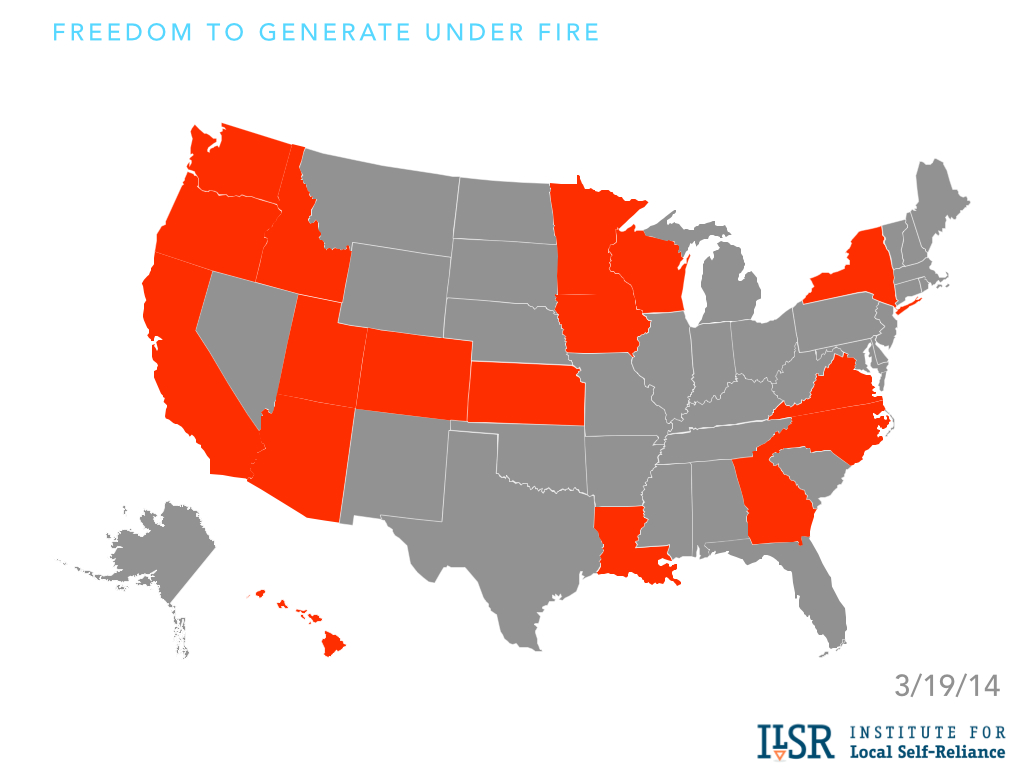Nuclear Power
New confirmation. New study: wind, solar power is cheaper than new nuclear. A new European study confirms what by now almost everyone except the U.S. Congress and White House seem to know: renewables are cheaper than new nuclear power–20% cheaper, even if construction of natural gas backup plants were to be required. Renewables alone, according to the study, are 50% cheaper than new reactors. “Wind and solar systems will dominate the power system in increasingly more countries,” Patrick Graichen, head of Agora Energiewende [which commissioned the study], said in an e-mailed statement. “The battle for the cheapest CO2-free power mix is decided.”
 The Entergy Corporation’s ongoing problems, chronicled well in these pages by Tim Judson on Tuesday, may not be entirely of its own making; it’s certainly not the only utility challenged by renewables and gas in the merchant electricity market. But Entergy does have a way of making things worse for itself. The latest: their idea to monitor the fish intake at the Indian Point reactors–an issue currently before the courts–by tying frozen sturgeon to the intake screens.
The Entergy Corporation’s ongoing problems, chronicled well in these pages by Tim Judson on Tuesday, may not be entirely of its own making; it’s certainly not the only utility challenged by renewables and gas in the merchant electricity market. But Entergy does have a way of making things worse for itself. The latest: their idea to monitor the fish intake at the Indian Point reactors–an issue currently before the courts–by tying frozen sturgeon to the intake screens.
Fortunately, federal fisheries officials didn’t buy the idea, pointing out that “frozen fish will likely decay differently than fresh fish. Also, tying them to the grates meant to keep out debris wouldn’t reflect the behavior of unrestrained fish.”
“The proposed study with frozen white sturgeon appears to be unnecessary and inappropriate to further the goals of the monitoring program. Additionally, any introduction of non-native species (even dead) into the river would need to be supported by documentation demonstrating that the individuals were disease-free and would not pose any risk to native species in the river,” agency regional administrator John Bullard wrote.”
Entergy will go back to the drawing board to try to come up with a different idea; the best idea would be for it to just give up and close Indian Point. That outcome will be Entergy’s fate sooner or later in any case.
The South Carolina Sierra Club and large energy users team up, challenge cost overruns at Summer nuclear reactor project. The South Carolina Supreme Court heard arguments on the case yesterday, which involves $278 million in cost overruns that the utility, South Carolina Gas & Electric, wants to pass on to ratepayers. The state’s Public Service Commission approved the utility’s request, and the groups then took the PSC to court. Of course, since the Summer reactors are far from complete, this may not be last case involving cost overruns at the project.
The Japanese government withheld relevant radiation data from areas where it is encouraging evacuees to return. According to the Asahi Shimbun, the data shows that levels of radiation remaining from the Fukushima disaster exceeded the long-term target of 1 millisievert a year at more than half of the surveyed locations, yet residents were allowed to return to the areas anyway–and weren’t told that the radiation levels were above targeted limits for rehabitation. Meanwhile, Japan’s Green Action has produced a short video, narrated in English by Aileen Mioko Smith, on evacuation planning in central Japan, and finds it wanting.

Europe is having no more success than the U.S. in finding permanent sites for its growing amounts of high-level radioactive waste. The European Union has called on its member nations to develop repository plans by next year, but few countries seem on target to meet that date–at least in terms of actually naming a site–which in most countries is expected to set off protest. One bit of good news here is that it appears Germany is giving up on its controversial Gorleben site in northern Germany, scene of many of the largest anti-nuclear protests of the past two decades in Europe. For those wanting a historical perspective, you can read my accounts of the 1997 Gorleben protests, involving 30,000 police and 20,000 protestors, and the next year’s protests at a similar site at Ahaus, here. Photos available there too.
You can always count on the nuclear engineering department at MIT for an unending string of bad ideas. Their latest: a new idea for floating reactors. Yes, the nuke folks at MIT think it would be a swell idea to build new nuclear reactors several miles off the coast where, they say, they would be unaffected by tsunamis and earthquakes, and where the ocean itself could serve as the ultimate cooling source in the event of a meltdown. It’s actually not a new idea–there was a serious proposal back in the 1970s to build a floating reactor off the coast of New Jersey, which was eventually abandoned as impractical and too expensive. And Russia is building smaller floating reactors to be used much closer to the coastlines–negating the ability to withstand tsunamis and other events. But, we’re pretty sure this idea will end up where the New Jersey one did–not on the ocean, but at the bottom of a stack of discarded engineering documents.
Clean Energy
Economist Charlie Komanoff wrote the first book on nuclear power plant cost escalation some 30 years ago–correctly predicting that nuclear power would be too expensive for private companies to continue building in the U.S. And he’s continued to follow the issue on and off since then; the point is: his track record has always been good. Yesterday, he published this piece on the New York Times’ (and some other publications) seemingly relentless coverage of the “failure” of Germany’s new energy policy, Energiewende, which is moving the country toward becoming the industrialized world’s first renewable-powered nation. He provides “ten packets of information” to refute the notion that the policy is failing; far from it: it’s actually quite successful so far and is likely to become even more so. Komanoff concludes, “Whether makeover, transformation, revolution, or all three, the energiewende is the most hopeful development in energy and climate policy this century. It, and our planet, deserve thoughtful coverage.”
In Utilities have four options to deal with the solar revolution, yet another investment bank, Sanford Bernstein, weighs in on the future of solar power and its effect on electric utilities, and comes to conclusions similar to those other banks have reached (see for example, Goldman Sachs sees a solar future for the U.S.–and that has nuclear utilities running scared). In this case, Bernstein points out that rooftop solar is leading to collapsed electrical demand during what has been traditionally utilities’ peak hours for use–and profitability. “Demand during what was one of the most profitable times of the day disappears. With it, the need for part of the merchant fleet disappears too for all but the dinner hour. And that is the issue competitive generators face globally in this 2020-scenario: how to live off demand of two hours a day.”
“These are those choices as laid out by Bernstein.
1. Refuse to accept power into the grid that has been generated from roof-top solar systems (or pay a reduced rate for that electricity). These steps are being adopted or proposed in Hawaii and California currently. This merely creates economic incentives for homes and businesses to start thinking about domestic energy storage solutions. (We can see similar things happening in Australia, where utilities are refusing connections or upgrades and/or are forcing consumers to downsize their plans)
2. Second, charge a connection fee to reflect the true value of the service (the ability to buy electricity whenever it is required, rather than the electricity itself). This step is being adopted in Arizona and California. But this step cements the attractiveness of battery storage to time-shift the power. (Again, this is taking place in a haphazard fashion in Australia).
3. Third, admit defeat and become a roof-top solar developer. (German energy giants RWE and E.ON appear to have realised this, as have US companies such as NRG)
4. We cannot think of a fourth option.”
The U.S. Energy Information Agency’s (EIA) renewable energy outlook is off by 20 years (and probably more). The EIA is the government’s most important source of statistical information on energy use and energy projections–so its reports matter. But somehow, the EIA, which acknowledges that renewables currently provide 13% of U.S. electricity–up from 9% in 2004 almost entirely on the growth of wind and solar–projects that renewables won’t reach 16% until 2040. Huh? It doesn’t add up. So the Sun Day Campaign has begun an effort to encourage EIA to improve its projections. “Given the relatively consistent growth trends of the past decade or longer for most renewable energy sources and their rapidly declining costs, it seems improbable that it will require another 27 years to grow from 13% to 16%,” said Ken Bossong, Sun Day executive director. “Thus, EIA’s forecast is not just unduly conservative; almost certainly, it is simply wrong.” Sun Day predicts that the 16% level EIA predicts for 2040 will actually be met by 2018–if not sooner. Full disclosure: the Sun Day Campaign works from NIRS’ offices, although it is a separate organization.
The California Public Utilities Commission is acting to force reluctant utilities to allow Solar City to continue its pilot program of installing back-up battery storage (provided by Tesla) to rooftop solar systems in the state. Solar City wants to show the program will be an economic success; the utilities are afraid of that exact outcome–and that it could lead to homeowners abandoning the grid when they have assurance of reliable solar power 24/7. Recent studies have shown that California solar costs, couple with battery storage, are dropping to the point where by 2018 it will be just as cheap for homeowners to install solar and leave the grid as it will be to buy electricity from utilities. And that trend will spread rapidly across the country.

An enormous question for solar choice. John Farrell of the Institute for Local Self Reliance explains net metering–which is a key factor in advancing the rooftop solar revolution–in an understandable fashion, but also argues that it may need to be replaced by what he calls “the value of solar,” a different means of ensuring that both those who install solar on their homes and utilities managing the grid can receive full benefit. The battle over solar policy is critical to the future of the solar industry, as Farrell writes: “In nearly 1 of 3 states, utility companies are trying to undermine policies that make it economical to produce energy from a solar panel instead of buying it from a utility.”
Inside Washington

Some people never give up. Rep. John Shimkus (R-Ill.) yesterday wrote an op-ed in The Hill newspaper blasting President Obama for cancelling Yucca Mountain (in 2009!) and says he “subverted” the Nuclear Waste Policy Act. Not so coincidentally, perhaps, electric utilities are the second largest contributor to Shimkus’ own election campaign and the largest to Shimkus’ PAC, which he uses to support other like-minded candidates.
The US Enrichment Corporation says it will receive yet another taxpayer bailout. The company, which filed for bankruptcy last month, says it has $9.6 million in taxpayer money it hasn’t yet spent, which will allow it to last the next two weeks. In a press release issued Tuesday, the company indicates that it is expecting an additional $57 million from taxpayers, subject to approval of Congressional Appropriations Committees–which have approved many, many millions of federal dollars to USEC already for its failed enrichment program. USEC claims this money is at no actual cost to the government–meaning that it requires no new appropriations. Instead, if USEC does indeed get this money, it will be transferred from other, potentially useful, programs to the useless financial black hole that is USEC.
Michael Mariotte
April 17, 2014
Permalink: https://www.nirs.org/2014/04/17/nuclear-newsreel-thursday-april-17-2014/
You can now support GreenWorld with your tax-deductible contribution on our new donation page here. We gratefully appreciate every donation of any size–your support is what makes our work possible.
Comments are welcome on all GreenWorld posts! Say your piece above. Start a discussion. Don’t be shy; this blog is for you.
If you like GreenWorld, you can help us reach more people. Just use the icons below to “like” our posts and to share them on the various social networking sites you use. And if you don’t like GreenWorld, please let us know that too. Send an e-mail with your comments/complaints/compliments to nirs@nirs.org. Thank you!
Note: If you’d like to receive GreenWorld via e-mail daily, send your name and e-mail address to nirs@nirs.org and we’ll send you an invitation. Note that the invitation will come from a GreenWorld@wordpress.com address and not a nirs.org address, so watch for it.



